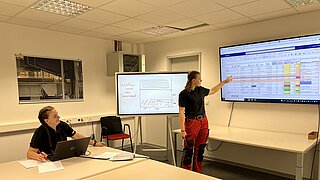Our four apprentices Celine Detering, Luisa Nolte, Marlon Wiech and Nathan Pötker (2nd training year) are sure that our hall gates offer potential for savings!
Their first thought: When opening and closing the gates, energy is lost through air circulation. How can this loss be kept to a minimum?
In a first step, the four trainees calculated the losses based on the size of the gates and put them in relation to electricity and gas costs. In this process, they could identify some gates where greater energy losses occur due to higher air circulation; for example, in the dispatch zone or in the cutting area.
After a creative brainstorming (even a helicopter transport of the material to avoid gate openings was briefly part of the - rather utopian - considerations), our trainees came up with four specific ideas for saving energy:
Equipment of the opening flaps with PVC lamellas to reduce draught
Integration of air curtains
Erecting lightweight walls to reduce air circulation
Automated control for gates
The four trainees currently review these approaches in terms of amortisation and the effort required to implement them and will present the details to the CEO and the management.
Within the framework of the Energy Scout project, it is not only possible to contribute ideas for energy saving, but also to present (partial) projects that have already been implemented during the participation.
Celine, Luisa, Marlon and Nathan are already very excited to see whether, and if so, which measures will be implemented after the presentation to the CEO and the management and how their ideas will be evaluated by the external jury of the energy scout project.
The Energy Scouts OWL project phase runs until end of September and must then be submitted to the Chamber of Commerce in form of a poster and a presentation. The independent jury then selects the nominated teams, and the award ceremony is planned for December.
For our four participants, however, the incentive of the competition is really not as decisive as getting to know the processes in the company and talking to many colleagues from different departments. "What are you actually doing there?" is certainly one of the most frequent questions they are asked. Developing, communicating, and implementing their own ideas in the company trains our trainees not only in team development, but also in project management, which they can experience live.
We are already looking forward to deciding which ideas can be implemented and no matter which place the jury awards our four trainees in the end, we are proud of our creative young talents!
